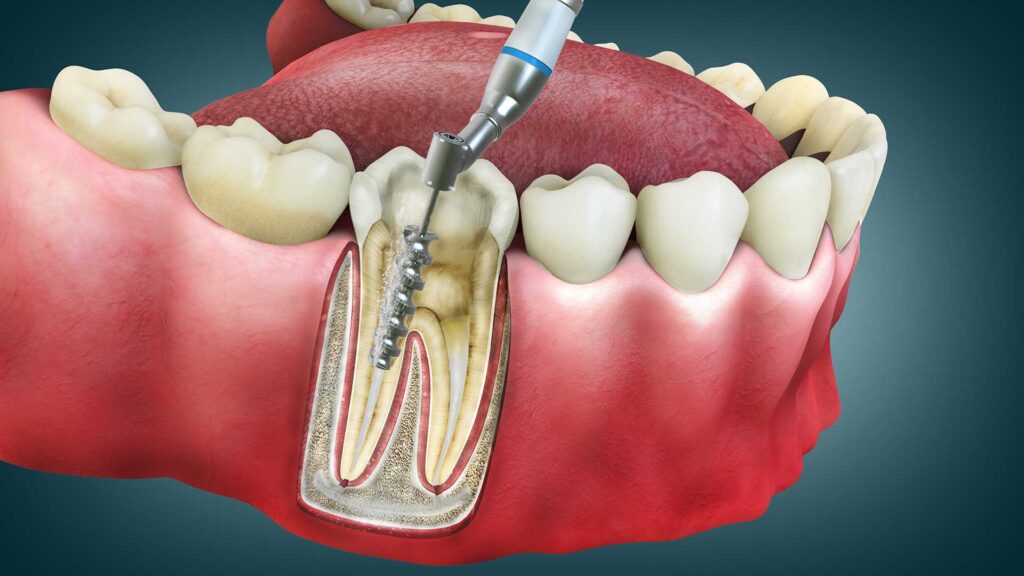
Root canal treatment (RCT) has long been associated with fear and discomfort. For many, the mere mention of it evokes images of pain and long dental visits. However, advancements in modern dentistry have revolutionized this procedure, making painless root canal treatment not only possible but also the standard in many dental clinics today. If you’re someone who dreads dental work, it’s time to reconsider how pain-free your experience can be.
In this blog, we’ll explore what a root canal is, why you might need one, and how painless root canal treatment has become a reality through modern techniques and technologies.
What is a Root Canal Treatment?
Root canal treatment is a dental procedure used to treat an infection or severe damage to the pulp (the soft tissue inside the tooth). The pulp contains nerves and blood vessels, and when it becomes infected due to deep decay, injury, or repeated dental procedures, it can lead to severe pain and swelling.
During a root canal, the infected pulp is removed, the inside of the tooth is cleaned, and the space is filled and sealed to prevent future infections. This procedure saves the tooth from extraction and restores its function.
Symptoms Indicating You Might Need a Root Canal:
- Severe tooth pain, especially when chewing
- Sensitivity to hot and cold that lingers
- Swelling or tenderness in the gums
- Discoloration of the tooth
- A recurring pimple on the gums
Why is a Root Canal Feared?
In the past, root canal treatment was often associated with pain because of the tools and techniques available at the time. Poor anesthesia methods and outdated instruments could make the procedure uncomfortable. Many patients would experience significant discomfort during and after the treatment, which led to the infamous reputation of root canals being painful and unpleasant.
However, these times have changed. Modern dentistry has drastically improved, focusing on making dental procedures as pain-free as possible. Today, painless root canal treatment is a reality thanks to cutting-edge technology and anesthesia techniques.
How Painless Root Canal Treatment is Achieved
1. Advanced Anesthesia Techniques
The key to a painless root canal begins with effective anesthesia. Dentists today use local anesthesia that thoroughly numbs the affected tooth and surrounding area. The process of administering anesthesia has also improved, ensuring even the injection itself is painless.
Modern dental anesthetics work quickly and are long-lasting, ensuring that patients remain comfortable during the entire procedure. Dentists also make sure that the patient is fully numb before beginning the treatment, reducing any possibility of discomfort.
2. Laser Dentistry
Laser technology has significantly advanced dental procedures, including root canal treatments. In some clinics, laser tools are used to clean and disinfect the root canal, reducing the need for traditional dental instruments. Lasers are precise and can target infected tissue more efficiently, reducing treatment time and minimizing discomfort.
Laser dentistry also promotes faster healing, as it is less invasive and causes less damage to the surrounding tissues.
3. Digital Imaging and Diagnostics
One of the most crucial aspects of painless root canal treatment is accurate diagnostics. Digital X-rays and 3D imaging tools allow dentists to get a clear and precise view of the affected tooth and its structure. This enables the dentist to plan the procedure effectively, minimizing any chances of complications or missed areas.
Accurate diagnostics also reduce the time spent in the dentist’s chair, making the entire experience quicker and more efficient for the patient.
4. Rotary Instruments and NiTi Files
Gone are the days of manual hand files that took a long time and often caused discomfort. Today’s root canal treatments are performed using rotary instruments, which are more efficient and precise. Nickel-titanium (NiTi) files, in particular, are flexible and durable, allowing dentists to clean the root canals thoroughly without causing unnecessary pressure or discomfort.
Rotary tools also speed up the procedure, making it less time-consuming for both the patient and the dentist.
5. Sedation Dentistry for Anxious Patients
For patients who are particularly anxious about dental procedures, sedation dentistry is an excellent option. Various levels of sedation can be used depending on the patient’s comfort level and the complexity of the procedure.
- Nitrous oxide (laughing gas): A mild sedative that helps patients relax while remaining conscious.
- Oral sedation: Involves taking a sedative pill before the procedure to ease anxiety.
- Intravenous (IV) sedation: For more significant anxiety, IV sedation can be used to help patients feel completely relaxed, with little to no memory of the procedure afterward.
With these options, even the most anxious patients can undergo root canal treatment without fear.
Benefits of Painless Root Canal Treatment
Choosing a painless root canal treatment has several benefits, both for your immediate comfort and long-term dental health.
1. Reduced Anxiety
Knowing that the procedure will be painless can greatly reduce anxiety. Many patients postpone dental treatments due to fear, leading to worsening conditions. With the reassurance of modern, pain-free techniques, there’s no need to delay.
2. Preservation of Natural Teeth
One of the main reasons for undergoing a root canal is to save the natural tooth. Extracting a tooth can lead to other complications such as shifting teeth, bone loss, and the need for implants or bridges. A root canal preserves the natural tooth, which is always the best option for oral health.
3. Quick Recovery and Minimal Discomfort Post-Procedure
With advanced tools and techniques, the recovery from a root canal is much quicker today. There is usually minimal discomfort after the procedure, and over-the-counter pain relievers can effectively manage any soreness.
4. Long-Term Cost Savings
While root canal treatments may seem costly upfront, they are often a more affordable option in the long term. Saving a natural tooth prevents the need for more extensive dental work in the future, such as implants, dentures, or bridges, which can be more expensive.
Post-Treatment Care
After a painless root canal treatment, it’s essential to follow the dentist’s instructions to ensure a smooth recovery:
- Take prescribed medications: If your dentist prescribes antibiotics or pain relievers, take them as directed to prevent infection and manage any post-procedure discomfort.
- Avoid hard or chewy foods: Stick to soft foods for the first few days to allow the tooth to heal without putting pressure on it.
- Practice good oral hygiene: Brush and floss regularly, but be gentle around the treated tooth.
- Attend follow-up appointments: Your dentist may recommend a follow-up visit to ensure that the tooth is healing properly and to place a permanent filling or crown over the treated tooth.
Conclusion
Root canal treatments no longer need to be associated with pain and fear. Thanks to modern dental advancements, painless root canal treatment is now a reality. From advanced anesthesia to laser technology and sedation options, today’s root canal procedures are designed to be as comfortable as possible.
If you are experiencing severe tooth pain or suspect you may need a root canal, there’s no need to suffer or avoid treatment. Schedule a consultation with your dentist to discuss the painless options available to you, and take the first step toward restoring your dental health without the fear of pain.
Remember, preserving your natural teeth through timely and effective treatment is always the best choice for your long-term oral health.


